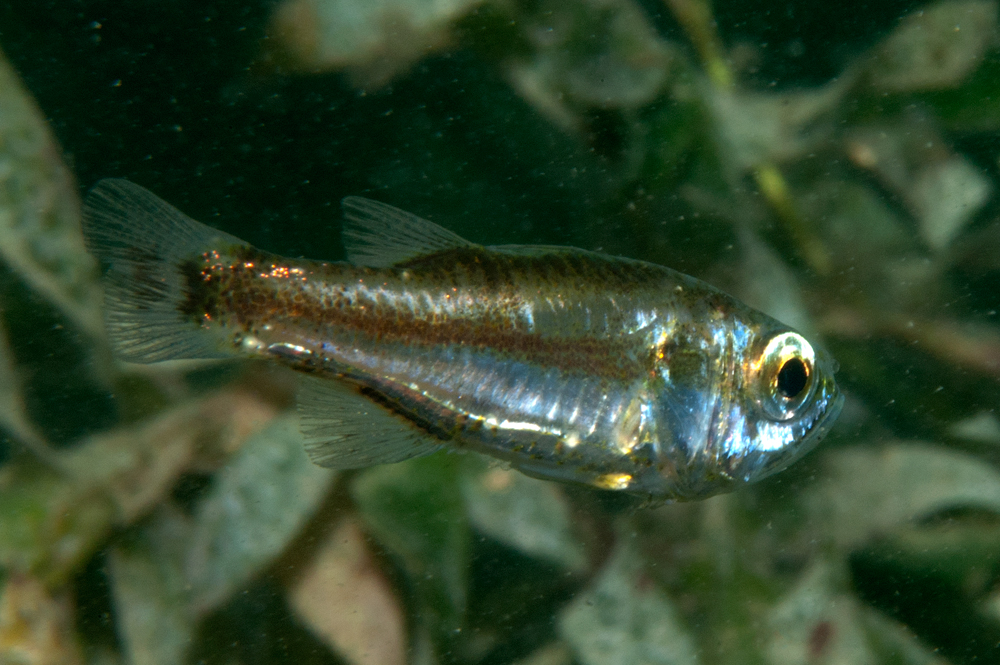- Classification
- ACTINOPTERYGII
- PERCIFORMES
- APOGONIDAE
- Siphamia
- cephalotes
Wood's Siphonfish, Siphamia cephalotes (Castelnau 1875)

Wood's Siphonfish, Siphamia cephalotes, at Flinders Jetty, Western Port, Victoria. Source: Julian Finn / Museums Victoria. License: CC by Attribution
A bronze to silvery-green siphonfish with a silvery tube-like light organ along the lower surface, a dark spot on the caudal-fin base, and a coppery midlateral stripe.
Wood's Siphonfish, Siphamia cephalotes (Castelnau 1875)
More Info
|
Distribution |
Widespread in southern Australia from Byron Bay, New South Wales, to Exmouth Gulf, Western Australia, and south to Cape Barren Island, Tasmania. Wood's Siphonfish inhabits shallow reefs in bays, estuaries and coastal waters. It is most active a night and is rarely seen by divers as it usually shelters under ledges, and among seagrass and kelp beds during the day. |
|
Features |
Dorsal fin VI + I, 7-9; Anal fin II, 8-9; Caudal fin 17; Pectoral fin 12-14,; Pelvic fin I, 5; Lateral line scales (tubed) 22-23; Median pre-dorsal scales 4-5; Gill rakers (1st arch) 4-6 + 14-16, developed rakers 1-3 + 13-16 = 15-18; Gill rakers on ceratobranchial 9-10. Body relatively slender, depth 3.2–4.8 in SL; body width 1.6–1.8 in depth; eye diameter 3.2–3.7 in head length; caudal-peduncle slender; preopercular edge and ridge smooth, the ventral edge slightly crenulate; palatines with 1-3 series of small teeth; first infraorbital pore a complex of about 7 small pores; tip of light organ on each side of tongue bound by a membrane. Scales large, mostly ctenoid (some cycloid); tubed lateral-line scales with a vertical series of papillae. Pectoral fin rays unbranched and compressed distally. First dorsal spine 1.1-1.3 in second spine; second dorsal spine 2.6-3.6, spine of second dorsal fin 5.1-6.7, and second anal spine 6.0-7.4, all in head length (HL); pectoral-fin length 5.8-6.7 and pelvic-fin length 5.7-6.1 in SL; caudal-peduncle length 1.05-1.4 in distance between pelvic spine insertion and anal-fin origin. |
|
Colour |
Individuals in seagrass habitats are usually greenish, while those inhabiting kelp beds are usually brown. Body overall pale silvery, head and abdomen with a greenish or yellowish hue, peppered with small dark brown dots; upper part of body from above eye, along dorsal-fin bases and upper part of caudal peduncle densely peppered with dark dots. Fins pale with faint small spots; anal-fin base with a line of dark brown dots or short dashes; caudal-fin base with a dark spot. Light organ a silvery stripe with dark dots along lower edge of body from pelvic-fin base tapering to along most of caudal peduncle. |
|
Biology |
Bacterial bioluminescent system present. Males incubate the developing eggs in their mouths. |
|
Remarks |
Unlike most bioluminescent cardinal fishes, Wood's Siphonfish harbours bioluminescent bacteria in two areas. One in the familiar disc-like, bacteria-harboring gland and paired elongate ventral bioluminescent reflectors, typical for this genus, that merge and end below the gill region. The second and more anterior site features two sacs that originate in the throat and protrude into the mouth, via the free space left by the laterally notched tongue. The bacteria live within the tips of these luminous sacs and the light diffuses within the mouth of the fish. The surface of the tongue is unique among cardinal fishes, being criss-crossed anteriorly by protruding dermal ridges, rich in taste buds and mucus-producing cells. It would appear that at night when feeding, the luminous mouth cavity of these fish acts as a lure to attract the small prey, while the ridged structure of the tongues surface facilitates their collection and aggregation before they are swallowed (Fishelson et al. 2005). |
|
Similar Species |
Wood's siphonfish differs from all other species in the genus Siphamia in having 15-18 developed gill rakers on the first arch. The Pinkbreast Siphonfish, Siphamia roseigaster has 13–15 developed gill rakers, a higher number of second dorsal- and anal-fin rays (9–11), and a higher number of pectoral-fin rays (14) that are mostly branched. It also lacks palatine teeth and the light organ in its mouth has a free ending. |
|
Etymology |
The specific name cephalotes is from the Greek kephalotos (= headed), presumably in reference to the large head of this species which is “not contained three times” in the total length. |
|
Species Citation |
Scopelus cephalotes Castelnau 1875, Researches on the fishes of Australia 2: 4. Type locality: Adelaide, South Australia. |
|
Author |
Bray, D.J. 2022 |
|
Resources |







